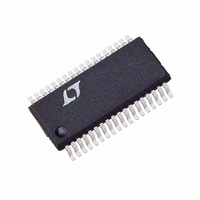LTC3716EG Linear Technology, LTC3716EG Datasheet - Page 13

LTC3716EG
Manufacturer Part Number
LTC3716EG
Description
IC SW REG STP-DN 5BIT SYNC36SSOP
Manufacturer
Linear Technology
Type
Step-Down (Buck)r
Datasheet
1.LTC3716EG.pdf
(28 pages)
Specifications of LTC3716EG
Internal Switch(s)
No
Synchronous Rectifier
Yes
Number Of Outputs
1
Voltage - Output
0.6 ~ 1.75 V
Current - Output
35mA
Frequency - Switching
120kHz ~ 310kHz
Voltage - Input
4 ~ 36 V
Operating Temperature
-40°C ~ 85°C
Mounting Type
Surface Mount
Package / Case
36-SSOP
Lead Free Status / RoHS Status
Contains lead / RoHS non-compliant
Power - Output
-
Available stocks
Company
Part Number
Manufacturer
Quantity
Price
Company:
Part Number:
LTC3716EG
Manufacturer:
KSS
Quantity:
50 000
Part Number:
LTC3716EG
Manufacturer:
LINEAR/凌特
Quantity:
20 000
Part Number:
LTC3716EG#PBF
Manufacturer:
LINEAR/凌特
Quantity:
20 000
Company:
Part Number:
LTC3716EG#TRPBF
Manufacturer:
Linear
Quantity:
736
Part Number:
LTC3716EG#TRPBF
Manufacturer:
LT/凌特
Quantity:
20 000
Company:
Part Number:
LTC3716EG-ES
Manufacturer:
LT
Quantity:
24
Part Number:
LTC3716EGN
Manufacturer:
LT/凌特
Quantity:
20 000
APPLICATIO S I FOR ATIO
directly with frequency. In addition to this basic tradeoff,
the effect of inductor value on ripple current and low
current operation must also be considered. The PolyPhase
approach reduces both input and output ripple currents
while optimizing individual output stages to run at a lower
fundamental frequency, enhancing efficiency.
The inductor value has a direct effect on ripple current.
The inductor ripple current I
decreases with higher inductance or frequency and
increases with higher V
where f is the individual output stage operating frequency.
In a 2-phase converter, the net ripple current seen by the
output capacitor is much smaller than the individual
inductor ripple currents due to ripple cancellation. The
details on how to calculate the net output ripple current
can be found in Application Note 77.
Figure 3 shows the net ripple current seen by the output
capacitors for 1- and 2-phase configurations. The output
ripple current is plotted for a fixed output voltage as the
duty factor is varied between 10% and 90% on the x-axis.
The output ripple current is normalized against the induc-
tor ripple current at zero duty factor. The graph can be
used in place of tedious calculations, simplifying the
design process.
Kool M is a registered trademark of Magnetics, Inc.
I
L
V
Figure 3. Normalized Output Ripple Current
vs Duty Factor [I
1.0
0.9
0.8
0.7
0.6
0.5
0.4
0.3
0.2
0.1
OUT
fL
0
0.1
1
0.2
U
V
0.3
DUTY FACTOR (V
V
OUT
IN
IN
RMS
0.4
U
or V
0.5
0.3 ( I
L
OUT
OUT
0.6
per individual section, N,
/V
:
IN
0.7
W
O(P–P)
1-PHASE
2-PHASE
)
0.8
3716 F03
)]
0.9
U
Accepting larger values of I
inductances, but can result in higher output voltage ripple.
A reasonable starting point for setting ripple current is
Remember, the maximum I
input voltage. The individual inductor ripple currents are
determined by the inductor, input and output voltages.
Inductor Core Selection
Once the values for L1 and L2 are known, the type of
inductor must be selected. High efficiency converters
generally cannot afford the core loss found in low cost
powdered iron cores, forcing the use of more expensive
ferrite, molypermalloy, or Kool M
loss is independent of core size for a fixed inductor value,
but it is very dependent on inductor type selected. As
inductance increases, core losses go down. Unfortu-
nately, increased inductance requires more turns of wire
and therefore copper losses will increase.
Ferrite designs have very low core loss and are preferred
at high switching frequencies, so design goals can con-
centrate on copper loss and preventing saturation. Ferrite
core material saturates “hard,” which means that induc-
tance collapses abruptly when the peak design current is
exceeded. This results in an abrupt increase in inductor
ripple current and consequent output voltage ripple. Do
not allow the core to saturate!
Molypermalloy (from Magnetics, Inc.) is a very good, low
loss core material for toroids, but it is more expensive
than ferrite. A reasonable compromise from the same
manufacturer is Kool M . Toroids are very space effi-
cient, especially when you can use several layers of wire.
Because they lack a bobbin, mounting is more difficult.
However, designs for surface mount are available which
do not increase the height significantly.
Power MOSFET, D1 and D2 Selection
Two external power MOSFETs must be selected for each
output stage with the LTC3716: one N-channel MOSFET
for the top (main) switch, and one N-channel MOSFET for
the bottom (synchronous) switch.
The peak-to-peak drive levels are set by the INTV
voltage. This voltage is typically 5V during start-up
I
L
= 0.4(I
OUT
)/2, where I
OUT
L
L
is the total load current.
occurs at the maximum
allows the use of low
®
cores. Actual core
LTC3716
13
CC













